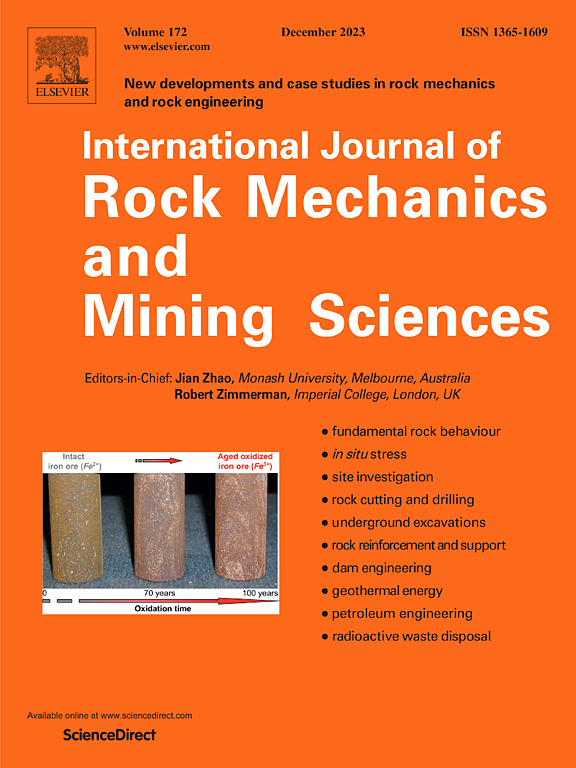Failure mechanism of deep TBM tunnels subjected to dynamic disturbance under true triaxial unloading stress path
IF 7
1区 工程技术
Q1 ENGINEERING, GEOLOGICAL
International Journal of Rock Mechanics and Mining Sciences
Pub Date : 2025-04-29
DOI:10.1016/j.ijrmms.2025.106128
引用次数: 0
Abstract
The peril posed by time-delayed rockburst significantly undermines the safety of deep-buried tunnel construction and operation, with dynamic disturbance recognized as a pivotal triggering factor. Vibration monitoring of critical Tunnel Boring Machine (TBM) components and surrounding rock surfaces within TBM-constructed tunnels shows that low-frequency dynamic disturbance affects the failure behavior of excavated surrounding rock. However, the mechanism underpinning instability of hard rock under dynamic disturbance during stress adjustment in deep excavations remains elusive. To bridge this gap, multilevel dynamic disturbance experiments (A = 1 MPa, f = 20 Hz) under true triaxial loading and unloading paths were conducted. The results indicate that dynamic disturbances can accelerate the failure of granite, with its strength reduced by 10 %–12 % under the combined effects of high-stress unloading damage. These effects diminish the energy storage capacity of rock mass, thereby lowering the threshold for rockburst occurrence. The deformation rates of granite increase with each phase of σ1 loading and σ3 unloading. Based on real-time deformation rate observations at the final stage, critical instability characteristics are categorized into two types: stress adjustment and dynamic disturbance. With prolonged exposure to dynamic disturbance, a distinct acceleration-stabilization-acceleration (V-shaped) pattern appears in the strain rate of dynamic disturbance-induced failure. Acoustic emission monitoring demonstrates the degradation mechanism in hard rock subjected to dynamic disturbance, leading to the initiation of tensile cracks and accelerating the propagation of cracks across fracture surfaces. Ultimately, the effect of supporting stress was evaluated through comparative testing. A regulatory strategy was proposed for controlling the evolution process of dynamic disturbance-triggered rockbursts, entailing the construction of a three-dimensional wave-absorbed support system for the excavated rock surrounding deep-buried tunnels. These findings provide a valuable reference for understanding, early warning, and controlling the mechanisms underlying time-delayed rockbursts triggered by dynamic disturbances.
真三轴卸荷应力路径下深埋TBM隧道动力扰动破坏机理
迟发性岩爆对深埋隧道的施工和运行安全造成严重危害,动力扰动被认为是关键的触发因素。隧道掘进机施工隧道内关键部件及围岩表面的振动监测表明,低频动力扰动影响开挖围岩的破坏行为。然而,深基坑开挖应力调整过程中动态扰动作用下硬岩失稳的机理尚不清楚。为了弥补这一空白,在真三轴加载和卸载路径下进行了多级动态扰动实验(A = 1 MPa, f = 20 Hz)。结果表明,动力扰动加速了花岗岩的破坏,在高应力卸载损伤的共同作用下,花岗岩的强度降低了10% ~ 12%。这些影响降低了岩体的蓄能能力,从而降低了岩爆发生的阈值。在σ1加载和σ3卸载过程中,花岗岩的变形速率随各阶段的增大而增大。基于后期实时变形速率观测,将临界失稳特征分为应力调整和动态扰动两种类型。随着动态扰动时间的延长,动态扰动破坏的应变率呈现出明显的加速-稳定-加速(v型)模式。声发射监测揭示了硬岩在动力扰动作用下的退化机制,导致拉伸裂纹的萌生并加速裂纹在断裂面上的扩展。最后,通过对比试验对支护应力的影响进行评价。提出了一种控制动力扰动触发岩爆演化过程的调控策略,并对深埋隧道开挖围岩建立三维吸波支护体系。这些发现为理解、预警和控制由动态扰动引发的延时岩爆机制提供了有价值的参考。
本文章由计算机程序翻译,如有差异,请以英文原文为准。
求助全文
约1分钟内获得全文
求助全文
来源期刊
CiteScore
14.00
自引率
5.60%
发文量
196
审稿时长
18 weeks
期刊介绍:
The International Journal of Rock Mechanics and Mining Sciences focuses on original research, new developments, site measurements, and case studies within the fields of rock mechanics and rock engineering. Serving as an international platform, it showcases high-quality papers addressing rock mechanics and the application of its principles and techniques in mining and civil engineering projects situated on or within rock masses. These projects encompass a wide range, including slopes, open-pit mines, quarries, shafts, tunnels, caverns, underground mines, metro systems, dams, hydro-electric stations, geothermal energy, petroleum engineering, and radioactive waste disposal. The journal welcomes submissions on various topics, with particular interest in theoretical advancements, analytical and numerical methods, rock testing, site investigation, and case studies.

 求助内容:
求助内容: 应助结果提醒方式:
应助结果提醒方式:


